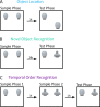Developmental onset distinguishes three types of spontaneous recognition memory in mice
- PMID: 32606443
- PMCID: PMC7326931
- DOI: 10.1038/s41598-020-67619-w
Developmental onset distinguishes three types of spontaneous recognition memory in mice
Abstract
Spontaneous recognition memory tasks build on an animal's natural preference for novelty to assess the what, where and when components of episodic memory. Their simplicity, ethological relevance and cross-species adaptability make them extremely useful to study the physiology and pathology of memory. Recognition memory deficits are common in rodent models of neurodevelopmental disorders, and yet very little is known about the expression of spontaneous recognition memory in young rodents. This is exacerbated by the paucity of data on the developmental onset of recognition memory in mice, a major animal model of disease. To address this, we characterized the ontogeny of three types of spontaneous recognition memory in mice: object location, novel object recognition and temporal order recognition. We found that object location is the first to emerge, at postnatal day (P)21. This was followed by novel object recognition (24 h delay), at P25. Temporal order recognition was the last to emerge, at P28. Elucidating the developmental expression of recognition memory in mice is critical to improving our understanding of the ontogeny of episodic memory, and establishes a necessary blueprint to apply these tasks to probe cognitive deficits at clinically relevant time points in animal models of developmental disorders.
Conflict of interest statement
The authors declare no competing interests.
Figures





Similar articles
-
Promoting and Optimizing the Use of 3D-Printed Objects in Spontaneous Recognition Memory Tasks in Rodents: A Method for Improving Rigor and Reproducibility.eNeuro. 2021 Sep 30;8(5):ENEURO.0319-21.2021. doi: 10.1523/ENEURO.0319-21.2021. Print 2021 Sep-Oct. eNeuro. 2021. PMID: 34503967 Free PMC article.
-
Ontogeny of spontaneous recognition memory in rodents.Neurobiol Learn Mem. 2021 Jan;177:107361. doi: 10.1016/j.nlm.2020.107361. Epub 2020 Dec 8. Neurobiol Learn Mem. 2021. PMID: 33307181 Review.
-
The expression of allocentric object-place recognition memory during development.Behav Brain Res. 2019 Oct 17;372:112013. doi: 10.1016/j.bbr.2019.112013. Epub 2019 Jun 5. Behav Brain Res. 2019. PMID: 31173799
-
Ontogeny of object versus location recognition in the rat: acquisition and retention effects.Dev Psychobiol. 2014 Nov;56(7):1492-506. doi: 10.1002/dev.21232. Epub 2014 Jul 3. Dev Psychobiol. 2014. PMID: 24992011 Free PMC article.
-
Moving beyond standard procedures to assess spontaneous recognition memory.Neurosci Biobehav Rev. 2015 Jun;53:37-51. doi: 10.1016/j.neubiorev.2015.03.013. Epub 2015 Apr 2. Neurosci Biobehav Rev. 2015. PMID: 25842032 Review.
Cited by
-
Evolution and function of neurocognitive systems in non-human animals.Sci Rep. 2021 Dec 8;11(1):23487. doi: 10.1038/s41598-021-02736-8. Sci Rep. 2021. PMID: 34880266 Free PMC article.
-
Promoting and Optimizing the Use of 3D-Printed Objects in Spontaneous Recognition Memory Tasks in Rodents: A Method for Improving Rigor and Reproducibility.eNeuro. 2021 Sep 30;8(5):ENEURO.0319-21.2021. doi: 10.1523/ENEURO.0319-21.2021. Print 2021 Sep-Oct. eNeuro. 2021. PMID: 34503967 Free PMC article.
-
CSMD3 Deficiency Leads to Motor Impairments and Autism-Like Behaviors via Dysfunction of Cerebellar Purkinje Cells in Mice.J Neurosci. 2023 May 24;43(21):3949-3969. doi: 10.1523/JNEUROSCI.1835-22.2023. Epub 2023 Apr 10. J Neurosci. 2023. PMID: 37037606 Free PMC article.
-
Maternal gastrointestinal nematode infection enhances spatial memory of uninfected juvenile mouse pups.Sci Rep. 2022 Jun 13;12(1):9796. doi: 10.1038/s41598-022-13971-y. Sci Rep. 2022. PMID: 35697723 Free PMC article.
-
Moderate effect of early-life experience on dentate gyrus function.Mol Brain. 2022 Nov 21;15(1):92. doi: 10.1186/s13041-022-00980-1. Mol Brain. 2022. PMID: 36411441 Free PMC article.
References
-
- Winters BD, Saksida LM, Bussey TJ. Object recognition memory: Neurobiological mechanisms of encoding, consolidation and retrieval. Neurosci. Biobehav. Rev. 2008;32:1055–1070. - PubMed
-
- Ennaceur A, Delacour J. A new one-trial test for neurobiological studies of memory in rats. 1: Behavioral data. Behav. Brain Res. 1988;31:47–59. - PubMed
-
- Bevins RA, Besheer J. Object recognition in rats and mice: A one-trial non-matching-to-sample learning task to study ‘recognition memory’. Nat. Protoc. 2006;1:1306–1311. - PubMed
-
- Dere E, Huston JP, De Souza Silva MA. The pharmacology, neuroanatomy and neurogenetics of one-trial object recognition in rodents. Neurosci. Biobehav. Rev. 2007;31:673–704. - PubMed
-
- Alvarado MC, Bachevalier J. Revisiting the Maturation of medial temporal lobe memory functions in primates. Learn. Mem. 2000;7:244–256. - PubMed
Publication types
MeSH terms
LinkOut - more resources
Full Text Sources

